So here I am in my local Sainsbury’s, doing my weekly shopping. Let’s see, what’s first on my list…? Ah, Apples. I like buying organic, if it’s not too much more expensive. Lets look at the prices:
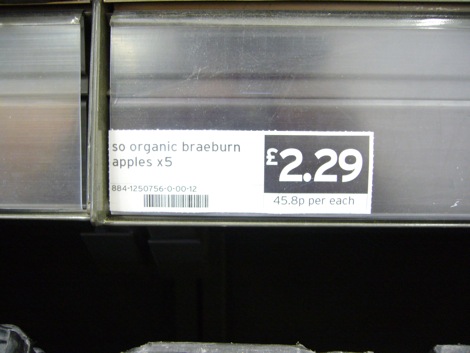
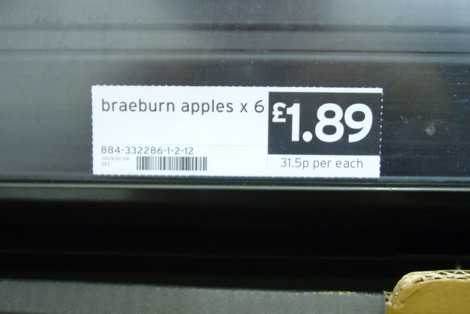
A bag of organic apples is £2.29, and a bag of normal ones is £1.89. OK the organic ones aren’t much more expensive, I’ll take them.
… But hang on a minute! If I was to take a closer look, I’d see the organic bag has 5 apples in, and the normal bag has 6. If I looked even closer I’d see that the price per apple is shown. That’s nice – it allows me to make an instant price comparison – if, that is, I am willing to take the time to lean in and read the small print. Since 30-40% of people in Europe and the US have myopia of some form, leaning in can mean having to get really close. And since 100% of us are in a hurry when we do our shopping, having to stop to read small print is frustratingly time consuming. It’s much easier to just make a quick judgment call based on your gut feeling. This is exactly what the supermarkets want you to do – inaccurate estimations and emotional judgments.
When you have about 800 stores and 16 million customers per week, persuading a small fraction more customers to buy the higher price items can equate to a healthy increase in profit. In this case, a bit of of smoke and mirrors involving typography and bag size is probably just enough to produce the results they want.
Let’s see what’s next on my shopping list… Ah, aubergines. Do I buy the bag of “basics” aubergines, or do I buy the much juicer looking individual ones?
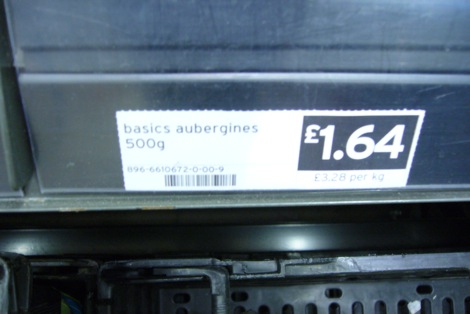
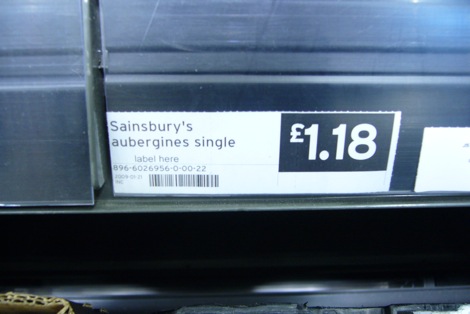
I know from earlier that I can just read the small print to make a direct comparison. …Er, wait a minute. Where’s the helpful small print? It’s gone.
Now, if I knew the weight of each item, I could whip out my trusty pocket calculator and do an exact comparison. But since the unpackaged aubergines are priced per item, and the packaged ones are priced by weight, I can’t work it out. Do you remember how, when you were a kid, you used to see scales in the fruit and vegetable aisle? Funnily enough, you don’t get them any more. Since I can’t compare on price, I am going to have to make an emotional judgment based on attractiveness. Mmmm, that individual one sure looks beautiful. Anyway, lets continue with my shopping. Next on the list is onions.
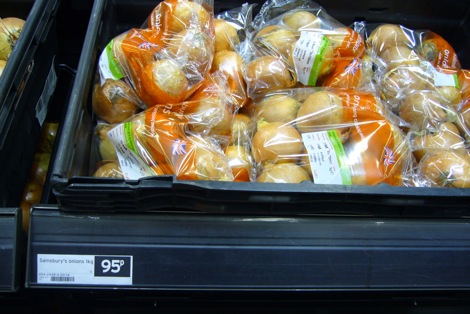
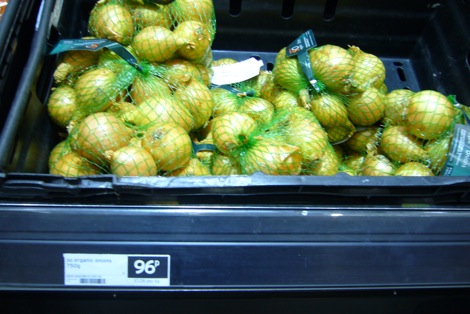
Look, organic onions are only 1 penny more. What a bargain! … No, wait, the organic bag is 750g, and the normal bag is 1kg.
Once again they are messing with the bag sizes to reduce the perceived price difference. If the organic bag was also 1kg, it would be £1.28. Perhaps this is a big enough difference to make a percentage of their 16 million customers per week to opt for the cheaper option. Meaning less revenue. Hmmm.
Estimating 25% of 96p isn’t particularly hard, but it’s hard enough. According to Gross-Tsur et al. (1996), 6.5% of the population suffer from dyscalculia, (the math equivalent of dyslexia) making this kind of mental arithmetic tricky for them. And in any case, even if you’re pretty good with your mental arithmetic, you don’t want to be having to do hundreds of calculations every time you go to the supermarket. Doing your weekly shopping takes long enough as it is.
The clever persuasive psychological techniques used by supermarkets is something that’s written about in Tim Harford’s Undercover Economist, and Paco Underhill’s Why We Buy. If you’re interested, go read them.
In US, a lot of the stores have “per each” on items that can’t be purchased as singles. for example, toilet paper. they’ll tell you (in small print) the per-roll price for the big packages — which is great! It means you don’t have to do the math.
Some quotes from Tim Harford:
On random mark-ups: “All shops want to offer competitive prices to customers who demand them, while charging more to customers who do not much care. Random mark-ups will do the trick: they are easily avoided by bargain hunters but will often snare the unwary.”
On packaging aesthetics: “‘Tesco’s Value range is packaged to look like a UN disaster relief package,’ he says. ‘It would cost virtually nothing for nicer packaging but they choose to have it that way to give a reason to people to buy the premium Finest range – people who are not price sensitive. I’m not saying don’t buy Tesco Finest. I just want people to understand the strategy and to look around when they’re shopping.’ “
Funnily enough, I noticed this technique in Sainsburys this week too – (the Aubergine example where they have the price for a single with no weight given vs the price for a pack). Is it a recent thing? Definitely smells of twisting the rules as far as they will bend.
Supermarkets tend to display all organic fruits and vegetables in one area, not as part of each product main category. For example, organic aubergines might not be in the aubergines section, but next to other organic products. As a result, price comparisons are harder. Less price sensitive customers will avoid walking around the shop to compare prices. Farmers/suppliers get such a small percentage that the additional price paid for organic is unproportional to the initial cost difference. Therefore, profit margins are much higher. It is unfortunate that some supermarkets use barely ethical tactics to promote more profitable products.
The book Tescopoly describes many tricks that supermarkets use.
Tescopoly: How One Shop Came Out on Top and Why It Matters
by Andrew Simms
@Simon – I’m hoping that by raising consumer awareness, some supermarkets will stop doing it, and make a big noise about how consumer friendly they are. The others will then have to follow suit. In theory. As @Hanford said, it’s common practice for all supermarkets in the US to have “per each” price comparison information. Perhaps it’s just a matter of time.
@Ofer – Yes, I’ve noticed the physical separation trick too. Though regarding the disproportionate markup on organic produce – doesn’t this leave space for an organic price war? I imagine that the “best price for organic” hook could make a pretty good advertising campaign.
Pingback: How Usable is YOUR World? » Dogbert Focus on Bad Experience
Down here in Australia, we now have unit pricing, and it is HEAVEN.
I can compare 1.5L Coke and 2L Coke (or whatever) and see what’s up.
No more price point trickery by Coles and Woolworths.
tim
Is it really so difficult to look at the unit pricing, on the bottom of the label? You can even see it, in the first pic. Organic braeburns are ~15p more expensive per apple.
@Joe – It’s not always that simple. For instance in Tesco loose apples are just labelled as £X per kg, whereas the bagged ones are per apple. So you can’t directly compare costs.
Pingback: User Interfaces Designed to Trick People | Serving Niches Blog
I know I’m coming in really late here, but in Wal-Mart I’ll frequently see TWO DIFFERENT PER comparisons. On, say, an 8 pack of charmin toilet paper, it’ll say per 100 ct (as in per 100 sheets), a valuable comparison tool. Then, on a 16 pack of charmin toilet paper (the _same type_, just more) it’ll say per oz, or some other measurement. It’s inconsistant on the exact same item and I honestly should start grabbing managers and complaining, although I’d probably just get a shrug and they’d walk away.